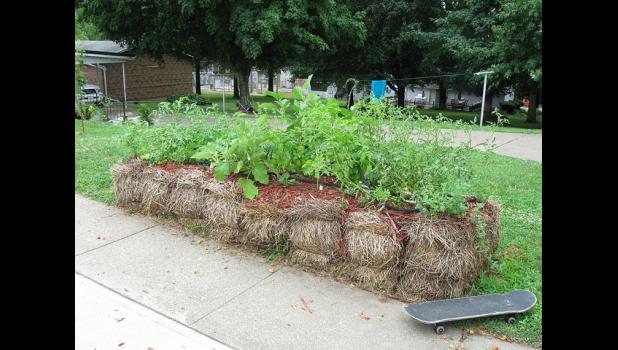Straw bale gardening offers options for gardeners; overcome poor soil and limited space
You can’t grow turkey in the straw. However, you can grow side dishes and floral centerpieces for a turkey dinner in the straw.
Straw bale gardens are becoming popular with growers who are plagued with poor soil or limited garden space, said University of Missouri Extension horticulturist David Trinklein. Straw bale gardening combines container gardening and raised-bed gardening into one green-thumb package.
You can grow many vegetables, fruits and flowers in a straw bale garden, Trinklein said. Cool-season varieties can be planted as early as mid-March if you cover plants with protective materials such as clear plastic or floating row cover.
Use bales of straw, not hay, for gardening, he said. Hay contains weed seeds and usually is too dense for best results. Choose bales held together tightly with twine. Farmers and local farm supply stores are good sources for straw. Avoid bales made from wheat or oats treated with an herbicide during production.
To assemble a straw bale garden, first choose a location that gets at least six to eight hours of direct sun. Once bales are watered, they become heavy and hard to move. If you place bales on the ground, Trinklein suggests putting them on a base of thick layers of newspaper to control weeds. Set bales so that twine is on the outside and cut ends face up. Place bales in single rows to allow best access, air circulation and sun exposure.
Successful straw bale gardening begins with conditioning the bales. This involves adding water and nitrogen to help bales partially decompose. This helps prevent nutrient tie-up once plants are added, Trinklein said.
Nitrogen deficiency is common in straw bale gardening. This happens when the soil microbes take nitrogen away from garden plants as they break down the organic matter in straw. If leaves turn yellow, you need to add more nitrogen.
To condition bales, soak them with water daily for 12 days. On days one, three and five, add ½ cup of a high-nitrogen fertilizer such as urea, ammonium nitrate or a lawn fertilizer to each bale. If you use lawn fertilizer, make sure it is not the “weed and feed” type, which contains herbicides that would harm garden plants.
Continue to water to activate the microbes and break down the straw. On days seven and nine, add only ¼ cup high-nitrogen fertilizer. On the 11th day, add 1 cup of a general-purpose fertilizer such as a 12-12-12 mix to each bale.
After the 12th day, touch the bale to check for heat. If it is cool to touch, you can plant.
To plant, dig small pockets or holes into the straw and set plants into the holes. Fill the holes with soilless medium and cover the plant’s roots. Water the base of the plant to settle the medium around the root system.
If planting seeds, put a layer of sterile potting media on top of the bale and tamp it down into the bale. Plant seeds according to package instructions.
Straw contains few nutrients, so feed the plants with a water-soluble, liquid fertilizer solution on a regular basis. However, do not overfertilize plants growing in straw bales, Trinklein said. Otherwise, you end up with plants lush with abundant vegetative growth and little fruit. Too much nitrogen causes pollen abortion and flowers fall off.
Be especially careful not to overfertilize vining crops such as cucumbers and melons. For sweeter-tasting melons, cut back on water when the fruits begin to size.
Continue to keep bales adequately watered during the growing season. Drip lines or soaker hoses may be helpful and eliminate hand watering.
Straw bales provide conditions for good root growth, especially for tomatoes. You will see few weeds, but mushrooms may appear, Trinklein said. Discard them. Earthworms like the nutrient-enriched bales and help plants thrive. You should see fewer pests than in conventional gardening.
Salad greens are a perfect choice for straw bale gardening, Trinklein said. You can enjoy greens up to frost, and even after frost with protection. Tomatoes, peppers, and eggplant also grow well in straw.
Although space in a straw bale garden is limited, avoid the temptation to crowd plants. Space them as you would if growing in soil. MU Extension’s “Vegetable Planting Calendar” (G6201) lists typical spacing for garden vegetables. It is available for download at extension.missouri.edu/p/g6201.
Unfortunately, straw bales last only one growing season. However, used bales make excellent compost.
Source: David Trinklein, 573-882-9631
For more than 100 years, University of Missouri Extension has extended university-based knowledge beyond the campus into all counties of the state. In doing so, extension has strengthened families, businesses and communities

